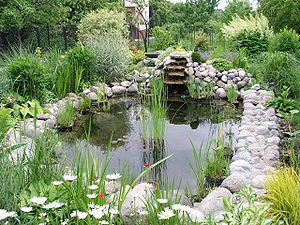Here are some tips on building your own fish pond:
Remember that a small backyard pond isn't just for fish, but also for butterflies, frogs, birds, you, and the whole family. These ponds may be quite small, even as small as 3 to 4 feet in diameter, which should be quite easy to maintain. These will not only provide enjoyment and visual interest but also a natural and relaxing environment as well.
Where to Build a Backyard Pond
| A pond in a residential garden. (Photo credit: Wikipedia) |
Landscaping
It is best to slightly elevate the soil surrounding the pond so that excess water will not drain into it. This can cause it to overflow, and in cases where you may have neighboring lawns, chemicals could flow into the pond and kill your fish. Plan the drainage system of the pond, making sure that it drains the water away from your house - not towards it.
Landscaping the surroundings around your pond will provide a natural dwelling place for birds and frogs that need water and land. Make sure that electricity is available if you plan to use lights, filters, or a water re-circulating device.
Using Pond Liners
Pond liners are used to keep water from leaking into the soil. This is almost always necessary for small ponds even if it they are situated in clay soils. Plastic pond liners come in different shapes and sizes. They even include built in waterfalls or any design based on your preferences. They are durable and convenient.
Pond liners come in different thicknesses as well. The thicker the pond liner, the more resistant it is to punctures. Cement may be considered as an optional pool liner. However, it requires more expertise to install and it may cost more than the regular plastic pond liner.
| (Photo credit: Wikipedia) |
Pond Installation
Time your pond building when the ground is not overly wet or frozen. Dig the hole according to the right depth and place (and secure) the pond liner. Then landscape the pond surroundings. Remove any rocks from the surrounding area. Add water, plants, and a pump. Let the pond sit for a few days before adding plants and fish. Let the plants settle for at least one week before placing the fish.
Then sit back and enjoy your backyard fish pond!
Resources to Help Build Your Fishpond:



Fishes are living beings and generate biological wastes like ammonia. This can happen in increased proportions if the fishes are over fed or the backyard fish pond is over stocked.
ReplyDelete